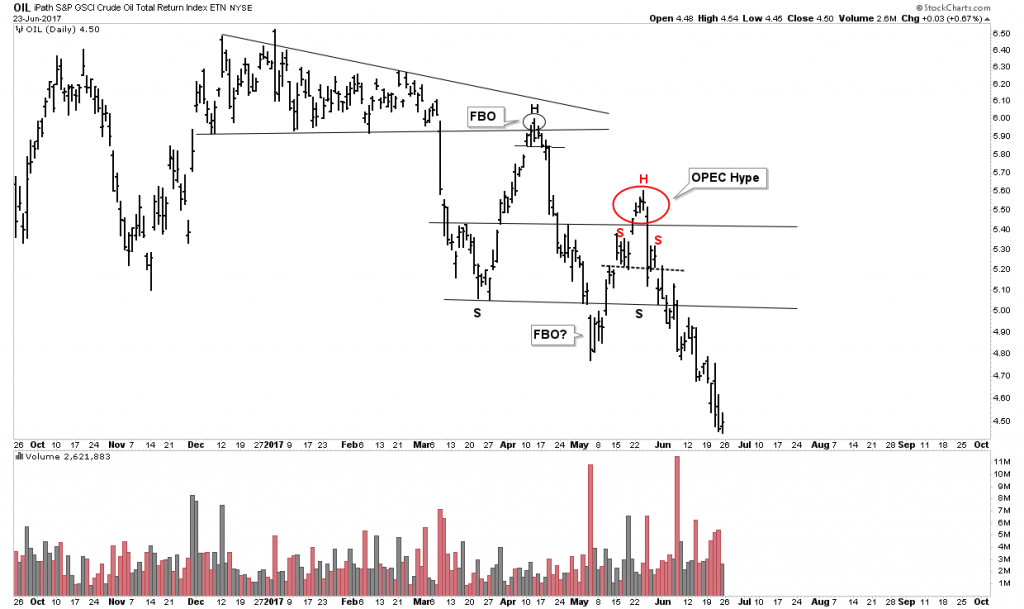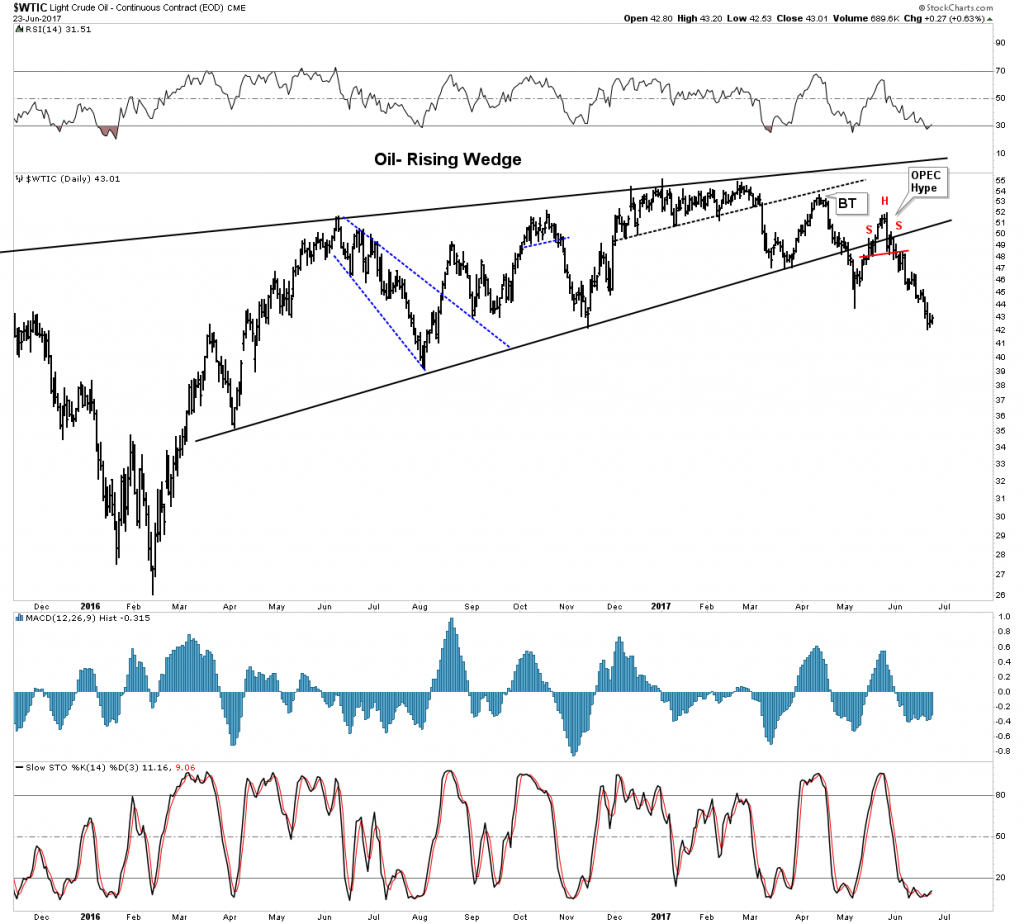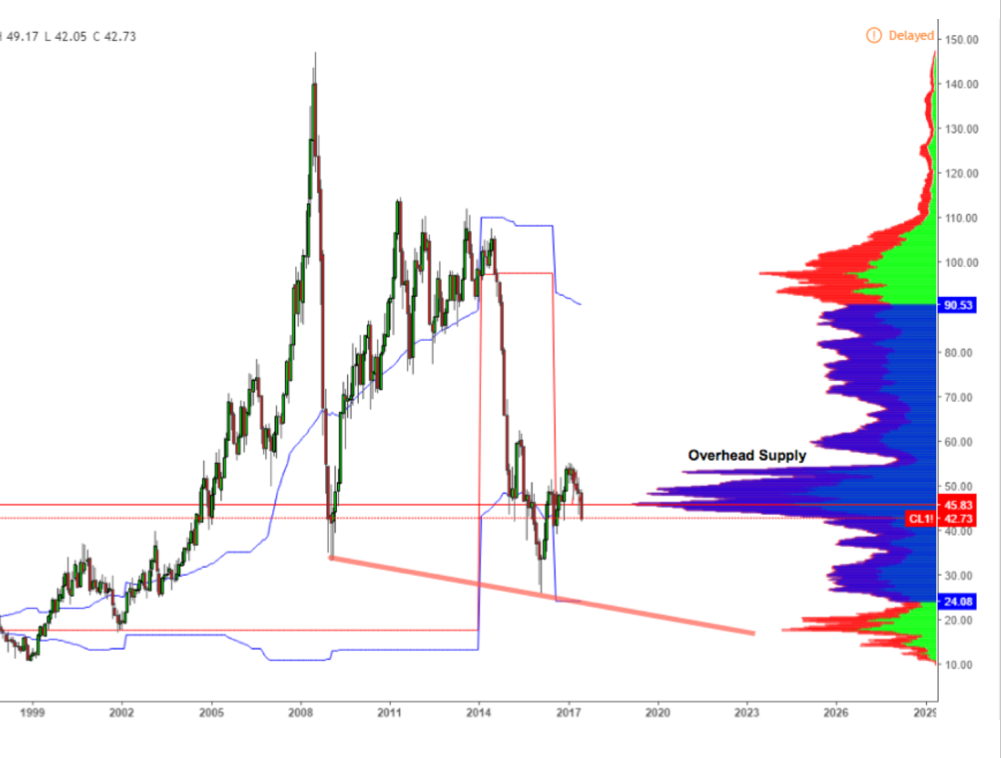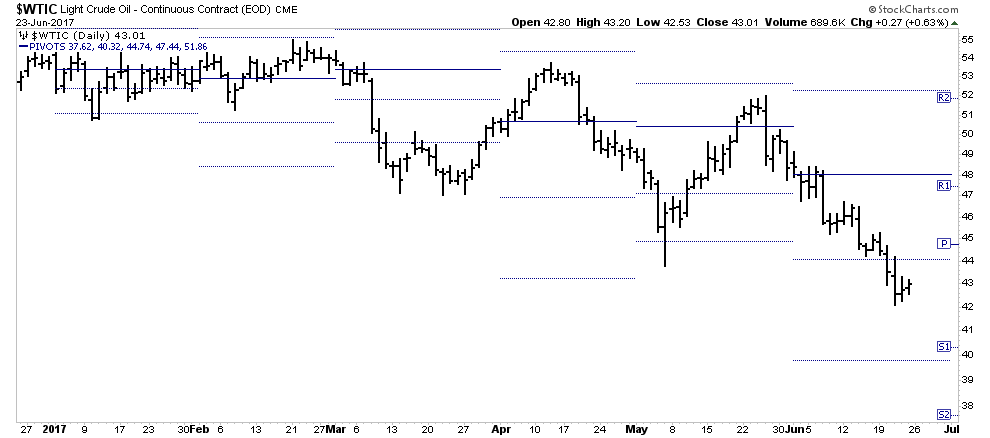I would like to put out a short update on the oil market. With the hard sell-off in the oil market of this past week this would seem a logical place to give it a rest and for a short seller to step over to the sidelines for a while. Anytime the market has gotten itself to this level of being oversold we have seen a rip to the upside.
One of the keys to being a successful short seller is to know when it's time to press one's bet. Extended moves to the downside come from oversold levels and I am going to show you why I believe we may have further to go to the downside before this current move is over.
You should recall we executed our first short position in oil in the beginning of March, just prior to oil falling out of the descending triangle . Keep in mind the dynamics of a descending triangle is where the ceiling of supply gets lower as time progresses.
Each time price rises it meets selling at a lower level. Note below (via iPath Goldman Sachs (NYSE:GS) Goldman Sachs) Crude Oil Total Return (NYSE:OIL)), once the triangle got established the higher volume bars were red, indicating sales volume. This was an in-your-face bearish announcement to anyone who cared to listen. But typically not many care to listen to the language of the market… so they were “surprised”.

Looking a the chart above, I have described it as a super-ball bouncing down the stairs. When a ball is rolled down the stairs the amplitude of the bounces increases with each progressive bounce. The reason for this of course is potential energy is being converted into kinetic energy. We see this dynamic in the chart above.
This is not just a coincident metaphor, but a market principle in energy dynamics. Recall how the oil price stayed in a bounded channel for 24 years between $10-$40 from 1980-2004. During that time it was coiling energy. When it finally broke out, it had the propulsive power to run to $147 over the next 3 years.
These physical dynamic images are useful in understanding markets. So what that means for us now is this market still has downward energy in it. The second bounce we saw, which occurred in the month of May was strictly based on OPEC-hype narrative. It immediately fell apart after the OPEC meeting.
Here is what this move looks like within the the bigger picture of the entire bounce off the lows of January 2016. We see how we built out a H&S right on the lower boundary of the rising wedge—that's classic. Also note how RSI, although low does not limit a move further to the downside.
Stochastics are flatlined on the bottom, NOT showing any case for an immediate upward move. MACD Histograms also do not have a pulse. Bottom-line: there is not yet any sign of a bounce taking hold in this chart.

The OPEC Narrative
I understand some prefer to focus on the charts and not the narrative, however I believe its useful to have knowledge of what’s going on behind the scenes. Besides, that’s how Plunger rolls when it comes to how I construct trades.
You must know that Saudi Aramco is positioning itself for a major IPO of its assets. Recall that an IPO is how insiders cash out of a market and “unload” their assets onto the public. This deal is in the works. It is estimated that this will be the biggest IPO in history.
Valuations are in the $2 Trillion neighborhood. Obviously, the higher the oil price the bigger the IPO, so we can see how imperative it is for the Saudis to keep the oil price up.
But here is the problem, the Saudi narrative has now developed into “the boy who cried wolf”. Their public efforts at managing supply to elevate price have been entirely discredited by the market. Cutting supply simply cedes market share in the world of financialized oil hedging contracts. Stated differently, all of OPEC's jawboning narratives are now shot.
ECON 101- Ingredients to a bull market
Now I have a question for you: Where is the chapter in your Econ 101 textbook which describes that a bull market can be based on decreasing supply? I must have been asleep in class on that day because I don’t remember that one. (Actually Econ 101 is nothing more than Keynesian indoctrination of course, where the only worthwhile thing taught is supply/demand curves… but I digress).
My point is that a bull market must be driven by increased demand. Supply typically rises along with the trend of higher prices. So what has occurred over the past 16 months is the market has been artificially moved higher without any rebalancing of supply and demand. Therefore this market is now currently out of balance.
This is simply a way to highlight that the entire structure of the oil market is an engineered facade. The free market eventually tears down facades, which is what I believe we are witnessing right now. The CBs of the world offer virtually free money which funds the frackers. The Saudis cut back market share and ramp prices to $55 where the frackers hedge future production. The frackers can now pump increasing amounts without regard to the oil price for 12-18 months. Its a recipe for an oil crash.
Volume Dynamics
This is where we Chatologists have an advantage. The charts reveal something is up. Rambus has often taught the principle of Symmetry. Stated differently, the way the market goes up is the way it goes down and vice versa.
Volume analysis is a similar concept. It’s what those volume-by-price bars are for on the left side of the chart. If there is little to no volume in a price range then there is little support or resistance. As a result price tends to move rapidly through these zones.
That’s what we have with the oil chart. Below I put the volume-by-price bars onto our bearish rising wedge chart and we can see a zone between $34-$41 having very thin volume. So breaching $41 unlocks overhead supply from any supporting structure which can hold it up. There is a possibility that we could witness a flash crash in the oil market from these levels down to as low as $34.

Another very important clue to future price dynamics can been seen by looking at the internal structure of this bearish rising wedge. Take a step back and notice how ALL of the bottoms in the chart above are sharp V-bottoms. I don’t have to tell you that V-bottoms are not the ingredients to a sustained move. V-bottoms cry out to be tested and are not foundational. Folks, what we see above is a picture of a developing crash.
Here is another view from Alastair Williams’ twitter feed showing the long term volume nodes which, on his chart, show overhead supply becoming un-locked at $42.

Pivot Point Support
Pivot points can be helpful to indicate where possible support can come into play. Here we show an S-1 at 40.32 and S-2 at 37.62. I regard pivot point analysis as marginal assistance; however it is one additional data point to be aware of.

What Could Go Wrong?
So what could de-rail this path toward Sub-$40 prices? Plenty of course. OPEC is in the false narrative business, so any engineered event could derail this move temporarily. A supply disruption scare would be the principle method of boosting the price and there are plenty of ways to engineer that over the short term. OPEC jawboning is obviously futile at this point, which explains why OPEC was so silent this past week.
So I am staying the course, I see the opportunity for a downward acceleration, however there is always the risk of a short covering rally for traders.
